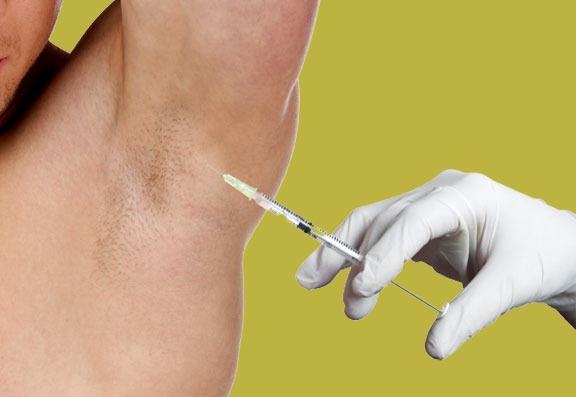Excessive sweating or hyperhidrosis is a problem that affects millions of people around the world – in fact, it’s thought that one in 20 people suffer from excessive sweating.
Although not a life-threatening medical condition, its impact on sufferers can be profound and a recent study found that people living with hyperhidrosis are often forced to adopt ‘coping mechanisms, whether that’s taking multiple showers, frequently changing clothes or having to ‘hide’ in dark, bulky or loose clothing.
If you suffer from hyperhidrosis, you may have felt you’ve tried all the available options.
Here’s our ultimate guide to the available treatments for excessive underarm sweating.
Antiperspirants
Antiperspirants are different to deodorants which just mask body odour but don’t actually reduce sweating and these over-the-counter or prescription topical products are often the first line of defence in combatting excessive sweating.
Antiperspirants containing aluminium chloride work as an astringent and aim to decrease sweat secretion, but they can often cause skin irritation and are often only effective for milder cases of hyperhidrosis.

Oral medications
There are some oral medications that can be prescribed to reduce sweating.
Most belong to a group of drugs called anticholinergics and work by blocking a chemical called acetylcholine which the nervous system uses to activate our sweat glands.
The drawback to these oral medications is that they work on the body as a whole so have a number of side effects, including dry mouth, constipation and can cause problems urinating, so most patients only use them for short-term relief.

Botox® injections
Injections of botulinum toxin into the underarms can temporarily block the signals from the brain to the sweat glands and results can last for several months.
Botox® injections for hyperhidrosis is a highly effective treatment and there is minimal risk of complications, but the major drawback is that the effects are short-lived, and this can become a very costly treatment if done privately.
Surgery
Endoscopic thoracic sympathectomy or ETS is the most common type of hyperhidrosis surgery and involves the nerves that control sweating being cut or clipped under a general anaesthetic.
Deciding to have ETS surgery is a significant step though as it carries a risk of serious complications and can cause people to excessively sweat elsewhere in the body and isn’t always 100% successful.
miraDry
miraDry is a new and innovative treatment for excessive underarm sweating; precisely controlled energy is delivered into the underarm area, eliminating the sweat glands.
These sweat glands can’t regenerate so results should be long-term after just one or two sessions.
As only 2% of our sweat glands are located in the underarms, miraDry doesn’t affect the body’s ability to regulate temperature and keep itself cool.

miraDry differs from temporary procedures like Botox® because it doesn’t require repeated treatments to achieve results. Unlike surgery, which can also deliver a permanent reduction in sweat production, miraDry doesn’t require incisions and can be performed under local anaesthesia and therefore there is no lengthy recovery.
Consultant Vascular Surgeon, Mr David Greenstein at Karidis Clinic revealed that MiraDry has the ability to reduce the production of sweat by up to 82 percent.
He said:
"miraDry is a very reliable treatment for excessive sweating and is clinically proven to reduce sweat production by 82% with impressive results after just one treatment. Some people will need a follow-up treatment.
Side effects can include swelling, numbness, bruising, and sensitivity for a couple of days post-treatment.
Some patients might experience an altered sensation in the underarm or upper arm skin but this gradually subsides.
Some patients worry that the treatment will prevent the body from effectively cooling down but we have between 2-4 million sweat glands in the body and only about 2% are found in the underarms, so after the treatment the rest of the body will continue to sweat normally, meaning it will have no problem cooling itself.
The treatment has an optimal safety record and is one of the most permanent sweat solutions available."
If you want to read more, the experts at Consulting Room really know what they're talking about and have put together some botox for excessive sweating, hyperhidrosis, botox (botulinum toxin), and miraDry FAQs just for you.
If you have more questions, you can use the hyperhidrosis, botox (botulinum toxin), and miraDry questions feature to talk to our panel of trained medical experts.
If you're keen to get started with any of these treatments right away then you're in luck - those clever folks also have a list of trusted, accredited hyperhidrosis, botox (botulinum toxin), and miraDry clinics in your area.
Many thanks to the author Mr Alex Karidis.
Mr Karidis is one of the UK's leading cosmetic surgeons. His clinic, the Karidis Clinic is the home of leading surgical and non-surgical aesthetic treatments in the heart of St John's Wood.
The flagship clinic offers the very best in treatments, procedures and thorough patient care provided by a carefully hand-picked team.

The skincare CEO who says SPF beats every anti-ageing cream on the market.
A recent outbreak of botulism in the UK has highlighted just how dangerous these treatments can be if you're not careful. Here's what you need to know to protect yourself.
Should aesthetic treatments be a one-off or something you should regularly consider? It’s important to find the right balance...
Hey, wait!
Before you go.....
Let's stay in touch, pop your details here and we'll send our editor's hand-picked updates on your fave subjects.